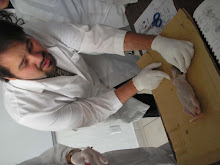After 3 weeks of vacations we finally return to school, we make a quick feedback about vertebrates, (living organisms with a spinal cord, bones and a skull).
We start with a new topic “Genetics”, what is genetics? It is the science that studies how features are passed down to one generation to another, Gregor Mendel was the first one to discover how genetic works by his study of pea plants, he crossed different types of pea plants and he realized that the results have something very similar with the plant’s parents, “traits”, or “features”, which were a group of characteristics that match with the parents. Mendel used pea plants because of their easy grown of large numbers and easy manipulation, set aside, they posses male and female reproductive organs. He also noticed “allele”, Dominant and recessive, Dominant means that the trait will appear always, and recessive that the trait will appear sometimes only, not in all generations. For example, a long time ago dogs, didn’t have a determine race, so what they did was crossed dogs that have a similar trait, sometimes the result didn’t have the same characteristics as their parents because the allele was recessive, so they keep on crossing until that trait became Dominant.
Mendel used the principle of probability, (chance of a possible event) to understand how genetic works, the chances of the plant to have a tall stem, the chance of the plant of having a different color, etc.
The concept of true breed also comes in here; it means that all future generations will share a certain trait.
Pea plants are self pollinating ;)
-True breed of pea plants
-Seed shape (Round-wrinkled)
-Seed color (Yellow- green)
-Seed coat color (gray-white)
-Podshape (smooth- constricted)
-Pod Color (green-yellow)
-Plant Height (tall-small)
-Flower Position (Axial-terminal)
If both the organism has both alleles (ex: T=brown eyes and t=green eyes) Tt, then the dominant “T”, is the one that will prevail.
Homozygous means that the organism has both of the same alleles (TT or tt)
Heterozygous means that the organism has different alleles (Tt)
T= Tall, t= small | T | t |
T | TT=The organism is going to be tall | Tt= The organism is going to be tall |
t | Tt= The organism is going to be tall | tt= The organism is going to be small |
Example:
If Daniel has Brown Eyes (Heterozygous), and has a baby with a woman with green eyes, what’s the chance of the baby to have green eyes?
Tt
T= Brown,t= Green | t | t |
T | Tt=The baby is going to have brown eyes. | Tt=The baby is going to have brown eyes. |
t | tt=The baby is going to have GREEN eyes. | tt=The baby is going to have GREEN eyes. |
Answer= 50%
Here’s is a table of some characteristics which are dominant or recessive:
Dominant | Recessive |
Freckles | No Freckles |
Dimples | No Dimples |
Curly Hair | Any other type of hair |
Dwarfness | Normal Growth |
Free Earlobes | Not free |
Role Tongue | Cannot role tongue |
Second toe larger | First toe larger |

No hay comentarios:
Publicar un comentario